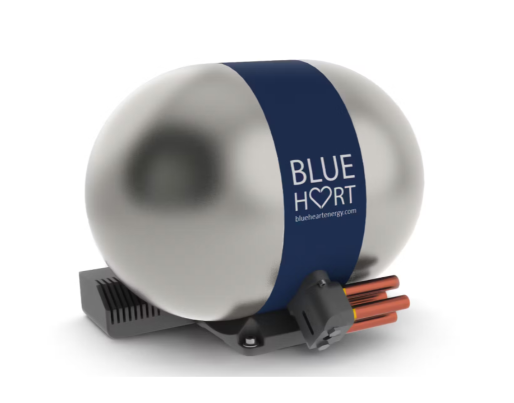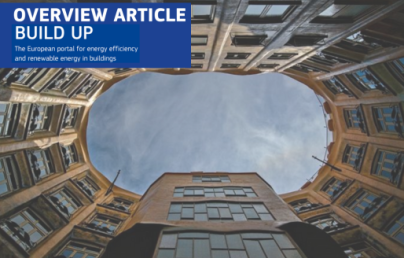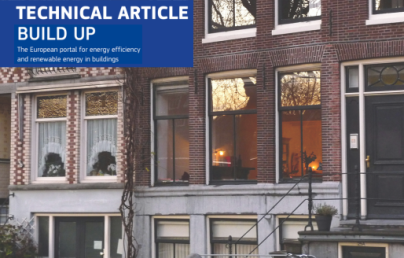Technical development and use-case aspects of thermoacoustic heat pumps for existing houses

Technical development and use-case aspects of thermoacoustic heat pumps for existing houses
Authors
Roelof Schuitema – BlueHeart Energy, LinkedIn profile
Michiel Hartman - BlueHeart Energy, LinkedIn profile
Alexander Weisz - BlueHeart Energy, LinkedIn profile
BlueHeart Energy LinkedIn profile
(Note: opinions in the articles are of the authors only and do not necessarily reflect the opinion of the EU).
Introduction
Today's heat pump technology has challenges which mainly relate to the EU ban on synthetic refrigerants with a significant greenhouse warming potential (GWP), the sound levels of heat pumps and the limitations to heat existing buildings with medium to high supply temperatures. Propane (R290) heat pumps seem to be the (only) answer from the industry, but they introduce limitations and/or costs due to the flammability of propane, while not fully solving the required sound levels and temperature challenges.
BHE comes with a technology that overcomes these hurdles to install heat pumps in existing buildings and retrofit situations. Several prototypes of the thermoacoustic engine have been built over the past three years, they prove the concept and benefits of the TA technology. The thermoacoustic heat pump engine has several unmatched benefits tackling the challenges of current day conventional vapour compression heat pumps.
Thermoacoustic technology:
Has no (flammable) refrigerants and no GWP working fluids,
Is silent,
Is flexible in temperature range and has no temperature boundaries,
Enables standardisation of production and installation,
Has a lifetime of 20 years.
This article explains the principles of thermoacoustics, what this is, how to build a TA heat pump based on the BH TA-engine, and what the next development steps are. Furthermore, we elaborate on specific use cases and how needs or market requirements provide input to the development process and how the TA benefits open new market perspectives.
The BlueHeart TA system
The TA engine we developed is an electrical-driven heat pump system, designed for a modulating output capacity of 1kW to 6kW and a size of 58cm x Ø45cm.
The system is a hermetically closed vessel filled with helium gas at 50 to 60 bar, two pistons opposing each other moving in a linear direction, powered by two electrical actuators. The pistons create an acoustic (or pressure) wave with amplitude of approximately 4 bar maximum at a frequency of about 60Hz, making a wave on of ±4 bar over the average of 60 bar. This piston/actuator system is the driver of the TA engine, it creates the acoustic power which drives the heat pumping.
The acoustic pressure wave is pushed into a specially designed round loop in which a TA-core is mounted. This TA-core consists of two heat exchangers, a regenerator, and an optional membrane barrier. One heat exchanger, the hot HX, is connected to the heating system of a house, the other heat exchanger, the cold HX, is connected to the heat pump source. The regenerator is placed between these heat exchangers.
The loop shape, the acoustic resistance, the gas volume, and frequency of the system are tuned in such a way that the generated acoustic wave feeds a traveling wave which exists in the loop. In the TA core the acoustic power of the traveling wave is performing the work to pump heat from the cold heat exchanger (heat pump source) to the hot heat exchanger (heating system). The driver adds the same amount of acoustic power that is used in the TA core to pump the heat.
In the TA core locally, the helium experiences a cycle of expansion, movement, and contraction, indicated schematically in the figure. The system is phased in such a way that the helium expands in the cold HX (D to A), moves through the regenerator (A to B) is compressed in the hot HX (B to C) and moves back through the regenerator towards the cold HX (C to D). The helium is the working medium picking up heat when expanded. Moving through the regenerator the gas is pre-heated and then heated further due to the compression in the hot HX. When moving backwards to the cold HX, the helium is cooled by the regenerator to then be expanded in the cold HX. The regenerator buffers and releases heat in the short period of the up and down gas movement from one to the other HX. Chapter 1 of the PhD thesis of Panhuis [1] gives a very good overview of all TA history and different configurations possible. Extensive descriptions, thermoacoustic principles and underlying mathematics are given in the book of Swift [2].
Figure1. The Stirling cycle of a TA standing wave system.
In this cycle the work is done to pump the heat, where environmental energy is picked up at the cold side and moved and released at the hot side as useful heat. The system pumps heat and operates between the externally applied temperatures by the flows over the liquid side of the heat exchangers, so the external applied flow temperatures of source and sink determine the working temperatures of the heat pump.
If the cold side is connected to a cooling system and the hot side to any dumping of heat, the system is cooling instead of heating. Hydraulicly switching sink and source gives a cooling system. By adjusting the stroke of the pistons of the forementioned driver, the output power can be modulated. The frequency remains fixed to the TA frequency as designed for the system.
Key aspects
The benefits mentioned in the introduction are related to the following aspects of the TA engine; because the systems use helium only as working medium in the gas phase, there is no evaporation or condensation, and the system can work between temperatures. Industrial TA systems can have delivered temperatures up to 180°C. The BH system is, for application reasons, limited to 80°C (by choice) supply temperature and about -20°C on the cold side. Helium is a non-flammable and non-toxic gas, and these aspects give a TA system the properties of being very flexible in types of source and sink temperatures.
The driver is designed with linear moving pistons on one axis and so they cancel each other’s vibrations. The system can be made as quiet as less than 35dB(A) this way. The pistons are the only moving parts in the system and they are dry running using a gas bearing, this gives very little wear and results in a lifetime of 20 years.
BlueHeart will supply the TA engine as complete and assembled vessels to the heat pump manufacturer, so they can directly assemble the unit into a full heat pump. Heat pump production is shortened and standardised this way. Due to its possibility to deliver high heating temperatures, relatively continuous performance over its power range, and its adaptation to any flow temperature, the installation is less complicated than the installation of vapour compression heat pumps.
Current status of development
Currently, the first market model prototype is operational and fully tested. This is a TA engine placed in a pressure vessel of 58cm width and 45cm diameter, designed to assemble and disassemble to be able to exchange components easily. In 2023 over 20 different configurations were tested, all by different combinations of piston-cylinder types, heat exchanger types, internal membrane configurations and regenerators.
Image 1. The 2023 pre-market prototype of the TA engine.
The 2023 pre-market model was built as a learning model, was used to validate numerical models and determine how to improve the next market model 2024. The 2023 model was also a test bench to characterise the driver of the system in build and was used to research efficiencies and piston wear. Main learnings were that the generated acoustic wave is partly lost before being effective in the TA core. Ways were found to improve the feed in of the generated acoustic wave into the TA core. The physics are clear now and translated into mechanical solutions and improved engineering for the next model. This will be a beta version of our final market model, to be launched in 2025.
In the meantime, with a second version of the 2023 model, an integration towards a complete heat pump system was integrated. The BHE engine is connected to the circulation pumps and controls of a 6kW heat pump replacing the evaporator, condenser, and compressor. Controls, hardware, and control logic are matched, and the system will be commissioned shortly.
Image 2 Left: Artist’s impression of the 2024 beta version market model, and Right: Impression of the TA engine integrated in a heat pump.
Figure 2. The relative performance of the BH system on sound, market fit, SCOP, and safety.
Predicted market machine and its application
The heat pump market in Europe is growing, heat pumps are seen as a cornerstone enabling technology to heat houses that are energy neutral or for climate proofing. At the same time, the market share of heat pumps in existing buildings is lagging behind newbuilds. Today’s vapour compression heat pumps are not always suitable for one-to-one installation in existing buildings. They tend to take up space, whether indoors or outdoors, and don’t deliver higher temperatures with adequate efficiencies that are needed for existing sink systems, are noisy and expensive compared to gas or electric boilers.
In the meantime, EU regulations have started to and will continue to accelerate the phasing out of synthetic refrigerants with a high greenhouse warming potential (GWP). Heat pump manufacturers are pushed towards using natural refrigerants, such as propane (R290) which has a low GWP but is highly flammable. Consequently, big outdoor monobloc R290 heat pumps are offered, or limited capacity heat pumps with a maximum charge of 150gr R290 indoors. The necessary safety measures come with a price and limits the application of (R290) heat pumps for many houses and residential buildings.
The BlueHeart TA heat pump is a breakthrough solution for existing buildings making use of thermoacoustic benefits. This enables direct gas boiler replacement and opens up the market, which is less likely with current vapour compression heat pumps. The BH system can generate heat at medium to higher temperatures, and house isolation or adjustments can be done by the house owner at their own pace and with potentially no changes to the sink/existing radiators being needed. The system is compact, has no safety limits and is silent to fit in smaller apartments and houses. This leads to the conclusion that the BlueHeart system can open the so called ‘blue ocean’ as discussed in Chan and Mauborgne [3].
The BlueHeart blue ocean are the existing smaller buildings, such as apartments and terraced houses with heat demands up to 6kW (or more if BH engines are cascaded). Over the EU countries that were analysed, 32% of the residential houses are small to medium terraced houses and 50% were apartments. For most of these houses there is no suitable heat pump solution at the moment.
Figure 3. BlueHeart Blue Ocean solutions
Besides existing houses, the BH heat pump will serve new builds as well, especially where the heat demand for space heating is decreasing and domestic hot water demand is growing since the BlueHeart efficiency for hot water production is very good.
Conclusion
Given the properties of thermoacoustic heat pumps, they give a solution to heating, cooling, and supplying hot water to smaller compact houses for which nowadays no convenient heat pump solutions are available. BlueHeart Energy is designing this solution, and we will come in 2024 with first beta version (field test) results and work, together with OEM's of heat pumps, on a market introduction from 2025 onwards.
References
[1] P.H.M.W. Panhuis, in 't, Mathematical Aspects of Thermoacoustics, 10.6100/IR642908
[2] G.W. Swift, thermoacoustics: A unifying perspective for some engines and refrigerators, 2nd ed. (ASA Press/Springer, 2017)
[3] https://www.blueoceanstrategy.com/authors/ - Blue Ocean Strategy


